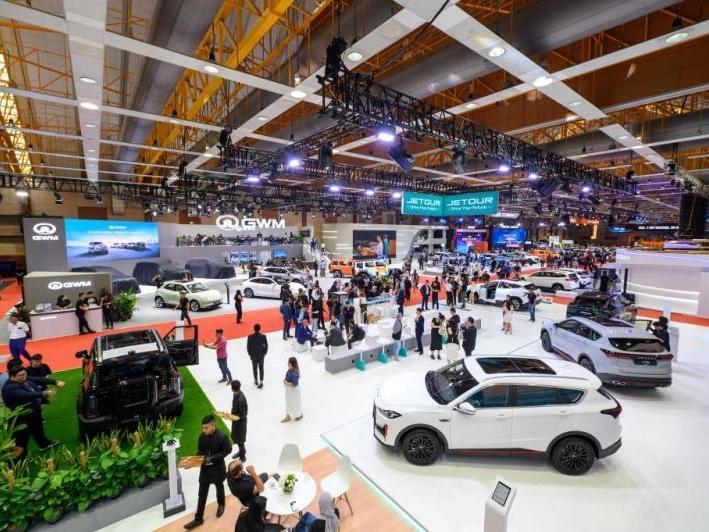Q
What is the safety rating of the GAC GS3?
The GAC GS3 has received the highest five-star safety rating from the ASEAN New Car Assessment Program (ASEAN NCAP). It excels in safety configurations, with the number of airbags varying across different versions. Some models are equipped with up to 7 airbags, including those for the driver's seat, front passenger seat, front side airbags, and front head airbags (curtains), providing comprehensive protection for occupants. Additionally, the vehicle is equipped with a series of active and passive safety systems such as ABS anti-lock braking, electronic stability control, lane departure warning, autonomous emergency braking, and forward collision warning. The body rigidity has also been enhanced through the use of GAC 2.0 high-strength steel, accounting for 36% of the total structure. Furthermore, it incorporates the Bosch ESP 9.3 electronic stability program to maintain directional stability during tire grip variations and enhance driving safety.
Special Disclaimer: This content is published by users and does not represent the views or position of PCauto.
Related Q&A
Q
What's the length of GAC GS3?
The lengths of different versions of the GAC GS3 is different. The length of the 2021 model is 4358 mm, while the lengths of the Standard and Exclusive versions of the 2024 model are both 4410 mm, and the length of the Premium R version is 4446 mm. The length of a car is an important dimensional parameter that affects the interior space layout and external handling flexibility. A longer body usually provides more spacious rear seats and trunk space. For example, the increased length of the 2024 model may show more abundant rear legroom and greater trunk capacity. However, in confined spaces such as alleys or compact parking spots, a longer body tends to be less maneuverable, potentially increasing parking difficulty.
Q
What is the fuel efficiency of GAC GS3?
The official comprehensive fuel consumption of different models of GAC GS3 varies. For example, the official comprehensive fuel consumption of all models in the 2024 GAC GS3 EMZOOM series (including Standard, Exclusive, and Premium R) is 5.9 L/100 km, while the official comprehensive fuel consumption of the 2021 GAC GS3 Standard and Premium is 6.9 L/100 km. However, the actual fuel efficiency is affected by various factors. In terms of driving habits, rapid acceleration, sudden braking, and prolonged idling will increase fuel consumption, while smooth driving helps improve fuel efficiency. Regarding road conditions, frequent starting and stopping on congested roads and driving at excessively high speeds on highways will both increase fuel consumption. Overloading the vehicle, such as keeping the trunk fully loaded for extended periods, will also lead to increased fuel consumption.
Q
What's the fuel consumption per liter of the GAC GS3?
The official comprehensive fuel consumption of different model versions of the GAC GS3 is different. For example, the official comprehensive fuel consumption of the 2024 model is 5.9L per 100 km. Calculated based on this data, each liter of fuel can approximately run 16.95 kilometers. The official comprehensive fuel consumption of the 2021 model is 6.9L per 100 km, meaning that each liter of fuel can run approximately 14.49 kilometers. However, it should be noted that these are only official data, and the actual mileage will vary due to factors such as driving habits, road conditions, and vehicle load. For instance, rapid acceleration, sudden braking, long periods of idling, and frequent traffic jams will increase fuel consumption and reduce the driving mileage per liter of fuel. On the other hand, smooth driving, reasonable use of air conditioning, and regular vehicle maintenance can help improve fuel efficiency and increase the driving distance per liter of fuel.
Q
Does the GAC GS3 support Android Auto?
The currently provided information of the GAC GS3 model does not mention whether it supports Android Auto. Generally, to check if a vehicle supports this function, you can refer to the vehicle's multimedia system manual or consult a GAC authorized dealer. Android Auto allows users to project apps from their mobile phones onto the vehicle's screen, providing convenient operations such as navigation and music playback. If the GAC GS3 supports Android Auto, the convenience and safety of using phone functions while driving will be greatly enhanced. However, if it doesn't support this function, basic audio transmission and other functions can still be achieved via Bluetooth connection to meet some in-car entertainment needs, or similar function of phone connectivity may be used for similar purposes.
Q
What is the fuel consumption of GAC GS3?
The fuel consumption of different models of GAC GS3 varies. The official combined fuel consumption of GAC GS3 is 5.9L/100km. However, the actual fuel consumption is usually affected by various factors, such as driving habits, road conditions, vehicle load, and environmental conditions. To reduce the vehicle's fuel consumption, you can develop good driving habits in daily driving, such as smooth acceleration and deceleration, rational use of air conditioning, and regular vehicle maintenance to ensure optimal performance.
Q
What's the size of the tank of the GS3?
The fuel tank capacities of different versions of the GS3 vary. The 2021 model has a 50-liter fuel tank, while the 2024 model has a 47-liter one. The fuel tank capacity directly affects the vehicle's driving range. A larger tank reduces refueling frequency and enhances travel convenience. It's important to note that the manufacturer-specified tank capacity refers to the volume from the bottom of the tank to the safe fill level. There is additional space between the safe fill level and the tank opening, designed to accommodate fuel expansion when temperatures rise, preventing overflow. Therefore, during actual refueling, the amount of fuel that can be added up to the tank opening may exceed the officially rated capacity.
Q
What type of transmission is the GAC GS3 equipped with?
Different models of GAC GS3 are equipped with different types of transmissions. The 2021 GAC GS3 Standard and Premium versions are equipped with AT (Automatic Transmission) transmissions. The 2024 GAC GS3 EMZOOM Standard, Exclusive, and Premium R versions are all equipped with DCT (Dual-Clutch Transmission) transmissions with 7 gears. AT transmissions offer mature and stable technology, delivering a comfortable driving experience. DCT transmissions provide faster shifting, higher transmission efficiency, and more direct power output, enhancing driving pleasure and improving fuel economy. Different transmission types can meet diverse consumer needs.
Q
What's the fuel consumption per 100 km of the GAC GS3?
The official combined fuel consumption of different model versions of GAC GS3 varies. The official combined fuel consumption of the 2024 model is 5.9L per 100km, while that of the 2021 model is 6.9L per 100km. The actual fuel consumption per 100km of the vehicle is affected by various factors, such as driving habits, road conditions, vehicle load, and usage of the air conditioner. Situations such as rapid acceleration, sudden braking, prolonged idling, and high-speed driving usually increase fuel consumption, whereas good driving habits like smooth driving, proper gear shifting, and maintaining an appropriate speed help reduce it. Actual fuel consumption usually fluctuates around the official data and may be higher or lower than the stated value. Car owners can optimize their driving habits in daily use to achieve better fuel efficiency.
Q
How much horsepower does GAC GA3 deliver?
The horsepower of different versions of the GAC GA3 models varies. For example, the 1.6L DCVVT engine equipped in some models delivers a maximum power output of 122 hp (90 kW) at 6,300 rpm and peak torque of 153 N·m at 4,500 rpm. In addition, 1.3T turbocharged engine equipped in other versions delivers 137 ps with 202 N·m of torque and 101 kW of power. Additionally, the 1.5T naturally aspirated engine capable of delivering up to 111 kW, which converts to approximately 151 metric horsepower (using the conversion factor of 1 kW ≈ 1.36 hp).
These diverse engine configurations meet consumers' varying performance needs and usage scenarios. If you prefer robust power, you can choose the higher-output engine versions, while the lower-horsepower engines can meet the need for smooth daily urban commuting.
Q
What is the top speed of the GAC GS3?
The top speed of different models of the GAC GS3 vary. Some models can reach a top speed of 190 km/h,which is competitive among vehicles in the same class, allowing the vehicle to easily reach legal speed limits on highways and meet the demands of fast commuting or long-distance travel. For instance, on sections with good road conditions and light traffic, a higher top speed enables smoother overtaking of slower vehicles. The actual driving speed is constrained by various factors such as traffic regulations, road conditions, vehicle load, and driving habits, so reaching the top speed is uncommon in daily driving.
Popular Cars
Model Year
Car Compare
Car Photo
Latest Q&A
Q
Does the 2019 Golf GTI have a timing belt or chain?
The 2019 Golf GTI uses a timing chain instead of a timing belt—a design that offers better durability and lower maintenance costs. Typically, a chain lasts as long as the engine itself and rarely needs replacement, whereas a belt requires inspection or replacement every 60,000 to 100,000 km. If neglected, a worn belt can snap and cause severe engine damage.
VW’s EA888 engine family has long relied on chain-driven systems, which are relatively quiet and highly reliable. That said, it’s crucial to periodically check the tensioner’s condition. Some earlier models experienced timing issues due to tensioner design flaws, but this was addressed in the 2019 version.
For performance enthusiasts, a chain system handles high-revving stress better, making it a common choice for hot hatches like the GTI. For daily driving, just stick to VW 50400/50700-spec oil as recommended in the manual—proper lubrication keeps the chain system healthy long-term.
One heads-up: If you hear noticeable metallic rattling near the front of the engine, have the guides or tensioner inspected ASAP. Unlike the telltale belt squeal before failure, this noise is a classic sign of chain-related wear.
Q
What is the recall on the 2019 GTI?
The 2019 Volkswagen Golf GTI was subject to a safety recall addressing two potential issues. First, the fuel pump control unit software could malfunction, potentially causing engine stalling in rare cases. Second, some vehicles might have rear suspension stabilizer link bolts that weren't tightened to specification, posing a loosening risk. Owners can visit authorized dealers for free software updates or bolt retightening.
These proactive recalls demonstrate Volkswagen's commitment to safety. Dealers often handle outstanding recall items during routine maintenance.
For performance-oriented models like the GTI, it's wise to go beyond recall checks. Pay close attention to the turbo system, DSG transmission fluid, and brake wear—these components endure more stress during spirited driving. If warning lights appear or you notice unusual noises, get a professional inspection promptly. Keeping the car in top shape ensures you can fully enjoy its dynamic capabilities.
Q
Does the 2019 GTI require premium gas?
The 2019 GTI does recommend using high-octane fuel (typically RON 95 or above). Its 2.0L turbocharged engine has a relatively high compression ratio, and premium gas ensures optimal performance while reducing knock risk. It also helps maintain engine cleanliness and long-term reliability.
While the car may tolerate lower-octane fuel (like RON 92), you’d see slightly reduced power output and fuel efficiency. Over time, it could also affect engine longevity. Turbocharged engines are particularly sensitive to octane ratings since turbos generate higher heat and pressure—high-octane fuel handles these conditions better.
Mixing different fuel grades occasionally won’t hurt, but sticking to the manufacturer’s recommendation is ideal. Also, periodic fuel additive treatments can help clean carbon buildup, especially for direct-injection engines.
One more thing: even with the same octane rating, fuel additive packages vary by brand. So, picking a reputable gas station matters too.
Q
How long will a 2019 GTI last?
The lifespan of a 2019 GTI largely depends on maintenance and driving habits. With regular oil changes, transmission fluid replacements, and avoiding aggressive driving, it can easily clock over 200,000 kilometers—or even more. Its 2.0T engine and DSG gearbox are proven combos, and as long as you stick to the factory service schedule, mechanical reliability won’t be an issue.
Just keep in mind: turbocharged engines demand extra care. Always use the right spec full-synthetic oil and monitor the cooling system. Climate plays a role too—hot, humid conditions mean paying extra attention to rubber seals and electronics. Every 50,000 km, have the timing chain and high-pressure fuel pump inspected (key items for turbos).
Driving style matters. Don’t redline it constantly, and let the engine warm up properly after cold starts. Rustproofing helps long-term durability, so regular underbody washes are smart. Nail these details, and this car’s built to last.
Q
How fast is the 2019 GTI?
The 2019 GTI truly delivers when it comes to performance. Under the hood lies a punchy 2.0-liter turbocharged four-cylinder, churning out 228 horsepower and 350 Nm of torque. Whether you opt for the engaging 6-speed manual or the lightning-fast 7-speed DSG, this hot hatch rockets from 0-100 km/h in just 6.3 seconds, with an electronically limited top speed of 250 km/h.
What really sets the GTI apart is its razor-sharp handling. The sport-tuned suspension and electronic differential lock work together to deliver precise steering and rock-solid cornering stability. It’s the perfect blend of everyday practicality and proper driver’s car thrills—a well-rounded hot hatch in every sense.
For enthusiasts, the GTI’s tuning potential is massive. Many owners go for ECU remaps or intake/exhaust upgrades to squeeze out even more power. Just remember to keep things street-legal—safety and compliance should always come first. Around here, these pocket rockets have a solid following, and it’s easy to see why.
View MoreRelated News

In Malaysia, which sliding door MPVs are available?
MichaelOct 30, 2025

Summarizing the 2025 Malaysia Auto Show, a large number of new cars were launched in Malaysia this year.
MichaelMay 12, 2025

GAC's latest electric car will be released in March, becoming a competitor to BYD Dolphin
AshleyJan 22, 2025

GAC M8 road test exposed again, new trend in electric MPV market!
JamesOct 12, 2024

China's all-new SUV makes a heavyweight entrance, AION HYPTEC HT launched in Thailand
JohnSep 24, 2024
View More


















Pros
Cons